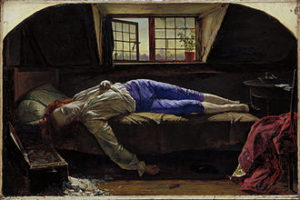Thomas Chatterton (20 November 1752 – 24 August 1770) was an English poet whose precocious talents ended in suicide at age 17. He was an influence on Romantic poets of the period including Shelley, Keats and Wordsworth.
Although fatherless and raised in poverty, he was an exceptionally studious child, publishing mature work by the age of 11. The first of his literary mysteries, the dialogue of “Elinoure and Juga,” was written before he was 12, and he showed it to Thomas Phillips, the usher at the boarding school Colston’s Hospital, where he was a pupil, pretending it was the work of a 15th-century monk called Thomas Rowley.
At 17, he sought outlets and patrons in London for his political writings, having impressed the Lord Mayor, William Beckford and the radical leader John Wilkes, but his earnings were not enough to keep him.
A fragment, probably one of the last pieces written by the impostor-poet, was put together by Dr Fry from the shreds of paper that covered the floor of Thomas Chatterton’s Brook Street attic on the morning of 25 August 1770. This fragment was identified by Dr Fry to be a modified ending of the poet’s tragical interlude Aella. The fragment is now housed in Bristol’s Public Library and Art Gallery.

His unusual life and death attracted much interest among the romantic poets, and Alfred de Vigny wrote a play about him, ‘Chatterton‘, that is still performed today. The oil painting (above) The Death of Chatterton by Pre-Raphaelite artist Henry Wallis, now in Tate Britain, has enjoyed lasting fame. A smaller version of the painting is housed in Birmingham’s Museum and Art Gallery.
